This article is the first instalment of our London Day of Nature recap, to share the valuable insights from the day both with readers who couldn’t attend and to re-inspire those who could.. Over two articles – one this month and one the next – we’ll highlight the key takeaways from the event. We hope you will be able to connect with the presentations and workshops that made the day memorable and share in the joy and curiosity they inspired among attendees.
On Saturday 26th October 2024, ecological enthusiasts across London united together once more for a truly wonderful celebration of nature in our capital. From the ‘dab hands’ to the ‘just-getting-started’ types, from the ‘let’s implement tried and tested guidance’ to the ‘what happens if we try this…’ folks, the day was a melting pot of creative thinking! Thank you to everyone who came along to London Day of Nature 2024. Your thoughtful discussions and openness to sharing experiences make the day the success it is every year. Thanks also to all our wonderful speakers, everyone who contributed a poster, and the GiGL and London Wildlife Trust staff who made the day possible.
If you attended, there’s still time to complete the feedback form here – we really value it!
This year we tried framing the day around one of the many possible ‘journeys of a recorder’, from learning the basics, to gaining a site-level understanding to the unfortunate but seemingly inevitable need to take up arms and protect your patch.
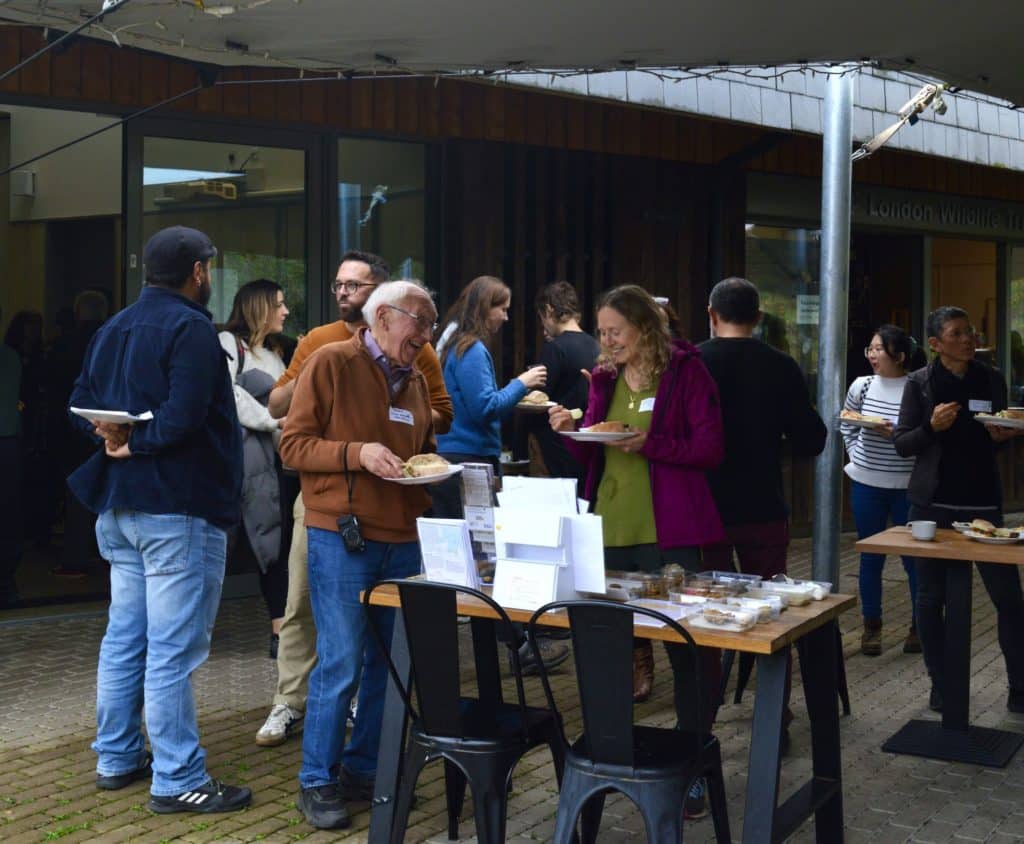
Setting the Conservation Agenda
Francis Castro and Sarah Smith of the Greater London Authority (GLA) began the day with impressive visions of ‘London’s Wild Future’ – one laid out in developing green infrastructure policies. Following on from last year’s update on London’s Local Nature Recovery Strategy (LNRS) and Biodiversity Net Gain (BNG), this year Francis and Sarah shared further progress from the Green Infrastructure Team at the GLA.
Since the last London Day of Nature, England’s 48 LNRSs have gradually taken shape, giving Francis and Sarah the unenviable job of coordinating this spatial strategy across all 32 London Boroughs and the opinions of some 6 million Londoners. Described as a ‘Project Pipeline for Nature Recovery’, the LNRS will define and crucially, map, the nature priorities, specific management actions (AKA ‘measures’) and the most suitable areas in which they should occur. Once the strategy is complete, it will help target funding for nature recovery projects to where it is both needed most, and will most feasibly make a difference, as well as define strategically significant areas in London for use in BNG calculations. A blueprint for the what, where and how of conservation.
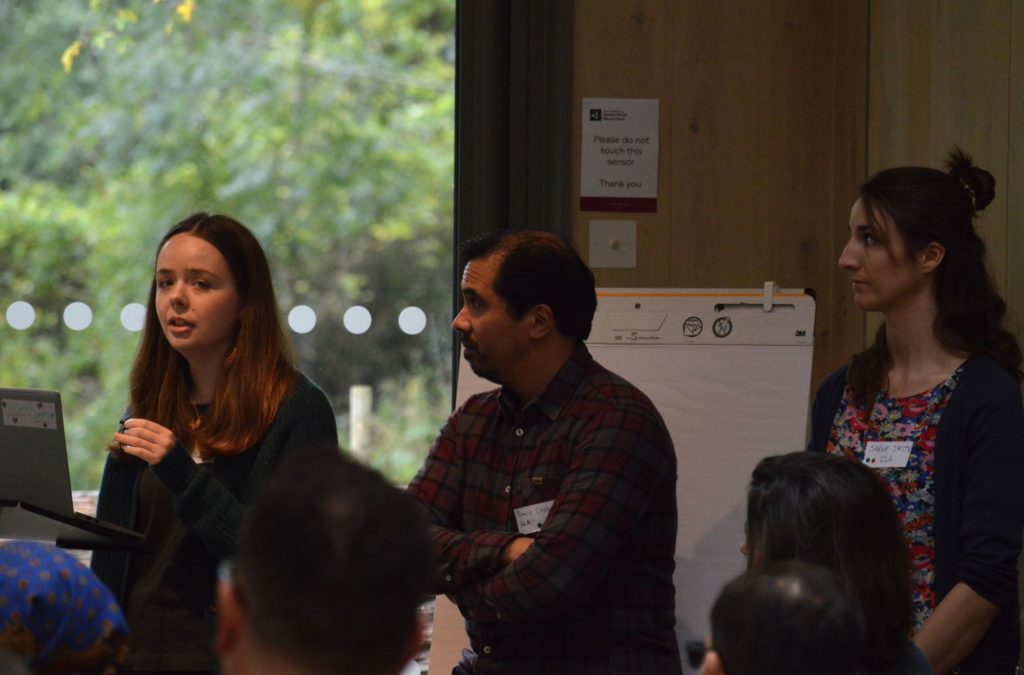
Throughout 2024, Francis and Sarah have worked passionately to communicate exactly what the LNRS is and what it isn’t – they have organised countless workshops, attended many events representing different demographics of Londoners and worked extensively with GiGL to get the LNRS message to as many people as possible.
On stage with Francis and Sarah was GiGLer Emily Hawkes, who has been leading LNRS delivery for GiGL through her role as Nature Recovery Data Officer. Emily shared how the whole GiGL Team have worked closely with the GLA to embed up-to-date and high-quality habitat and species data, along with expert opinions and public suggestions into the strategy. GiGL would like to take this chance to thank all experts who helped with this process, particularly the species experts who pored over data to shortlist priority species and to any individual who submitted one of 1700 opportunities to the interactive map.
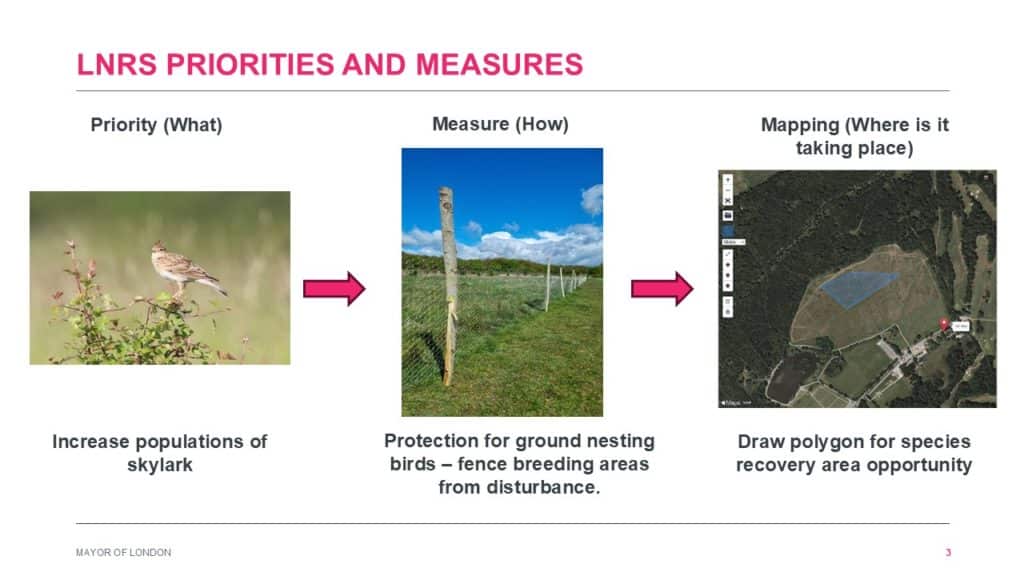
To LNRS naysayers, it’s a reinvention of London’s Biodiversity Action Plans, costing lots of money and man-hours to deliver a strategy without delivering any nature recovery. But to LNRS supporters, the London LNRS presents a democratic opportunity to integrate local, specialist knowledge into a policy, the efficacy of which will be observed, studied and evaluated by civil servants, practitioners and the public when the whole process is repeated in 3-10 years. A blueprint for nature recovery specific to London’s unique urban habitats which outlasts election cycles.
Sarah and Francis’ commitment to LNRS transparency has been admirable and for more updates from the GLA, you can subscribe to their Environment newsletter here. For LNRS updates and more from GiGL subscribe to the GiGLer newsletter, including our recently published Habitat Suitability Modelling. Most importantly, watch out for the draft LNRS map and public Spring consultation coming soon.
Ecological Praxis – be responsive and celebrate complexity
Our next speaker, Russell Miller from the budding ReNature London, outlined a similarly thoughtful and iterative process for ecological action, focusing on daily intervention. Russell is a veteran of conservation and arboriculture in East London. Experienced in delivering impact through work with Hackney Tree Musketeers and the Wildlife Gardeners of Haggerston, Russell and ReNature co-founder Nina Hundt strive for ‘intervention-plus’ in all that they do. That means reviewing and learning from your actions quickly and implementing new understanding the next time around.
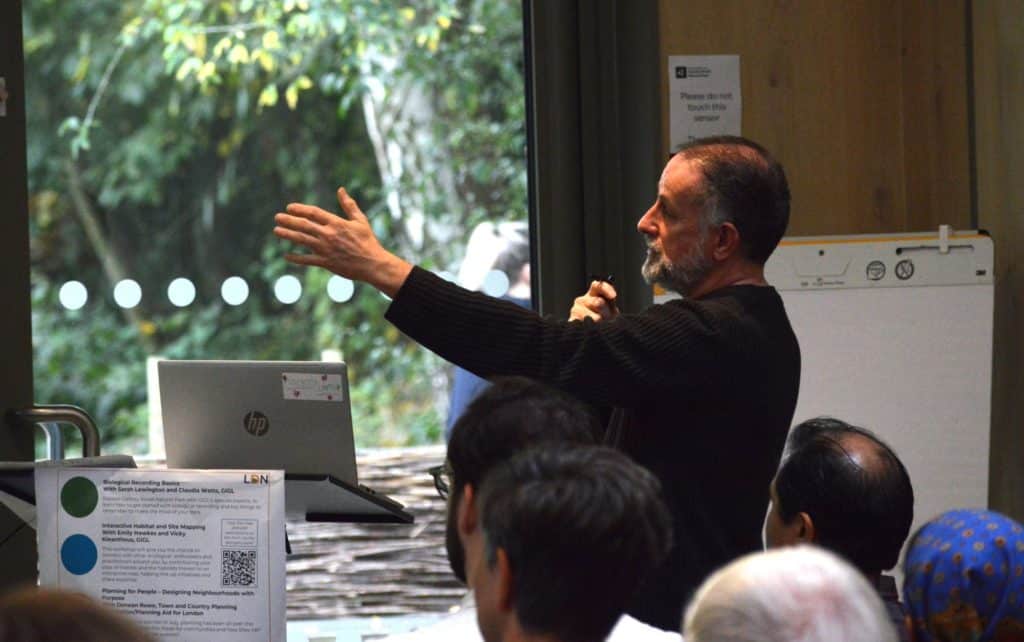
Grounded in his ‘Ecological Praxis’, Russell and Nina have been helping to ‘cultivate nature recovery’ and reintroduce ecological complexity at Hackney Wick and Hackney Marshes – and to great success! Through thoughtful interventions mimicking ecological processes like re-introducing deadwood on-site and coppicing, four species have already returned to Hackney Marshes – smooth newts, short-tailed voles, kestrels and whitethroats. They also estimate that there are 45 species in recovery. The spread of species across different trophic levels, suggests that they are doing something right!
‘Cultivating recovery’ is Russell’s perceptive nod to the need to work with people and systems to aid natural processes as well as the need to cultivate our internal ecological framework towards that of an ecosystem. As one would tend a garden to be mindful of external forces like sun exposure or rain, we must reflect upon the social and political frameworks that shape our practices around bureaucratic tools, rather than to the needs of nature.
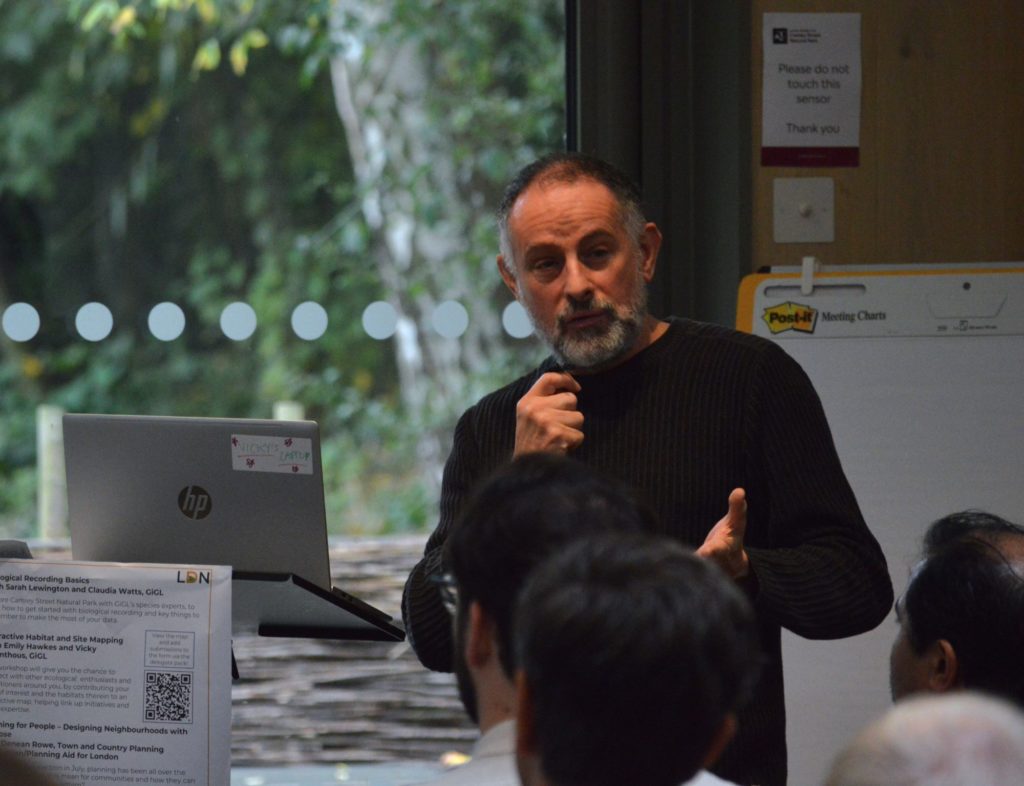
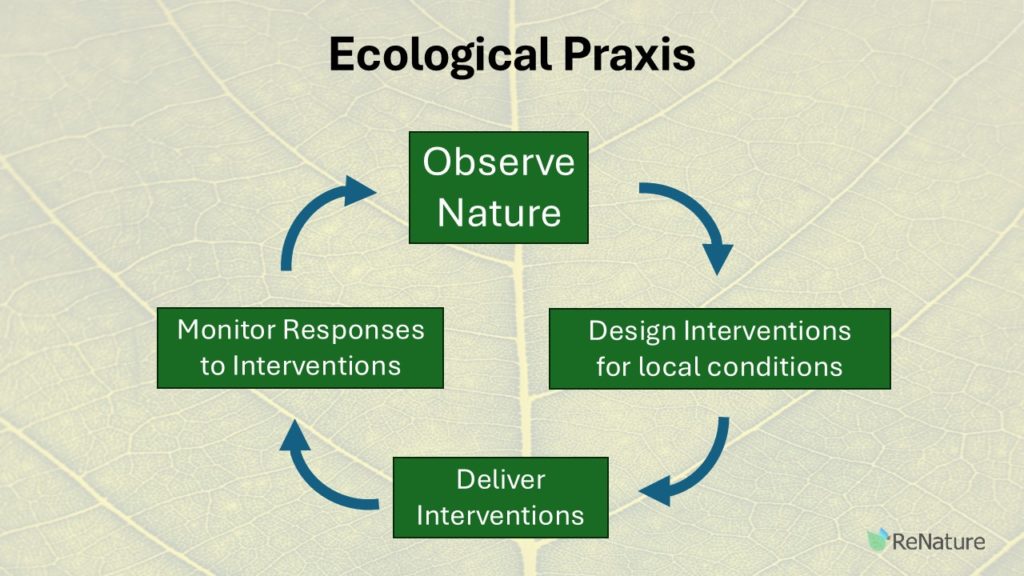
Russell’s slide on ‘Ecological Praxis’ combining theory and action, helping to re-nature landscapes and minds. Left image: © Louisa Bizzarri, GiGL Partnership Officer.
Speed Talkers – Collaboration, ‘Getting Stuck In’ and Taking Ownership
The interests of our next speaker and first speed talker, Di Clements from the London Geodiversity Partnership (LGP) span not just the recent history of London, but its deep past – the millions and billions of years before human influence began. In her talk, Di gave a brief overview of the work of the LGP and its aims to ‘identify, conserve and interpret’ sites of geological interest in London and elucidate the mysteries beneath our feet. The LGP’s commitment to education was typified by the stall of geological samples, manned by Di and LGP chair Laurie during registration at the start of the day. Geological samples and diagrams abounded at the London Geodiversity Society’s stall. Here, Di Clements shares a diagram of some of London’s stratigraphic layers.
GiGL and the LGP have been partners for over a decade during which time we have helped connect naturalists and geologists to appreciate London’s landscapes more deeply. Together, we have collaborated on London’s geodiversity dataset, maintaining geospatial information for each of London’s 70 sites documented in the London Foundations Report. The featured sites represent the best and often most accessible examples of London’s geodiversity, cementing their protection within planning policy and through education and engagement. The most recent proposal is the potential designation of the Natural History Museum’s new Prehistoric Garden as a ‘Locally Important Geological Site’ (LIGS). You can read more about the LGP’s recent work in two GiGLer articles published in 2024 here and here.
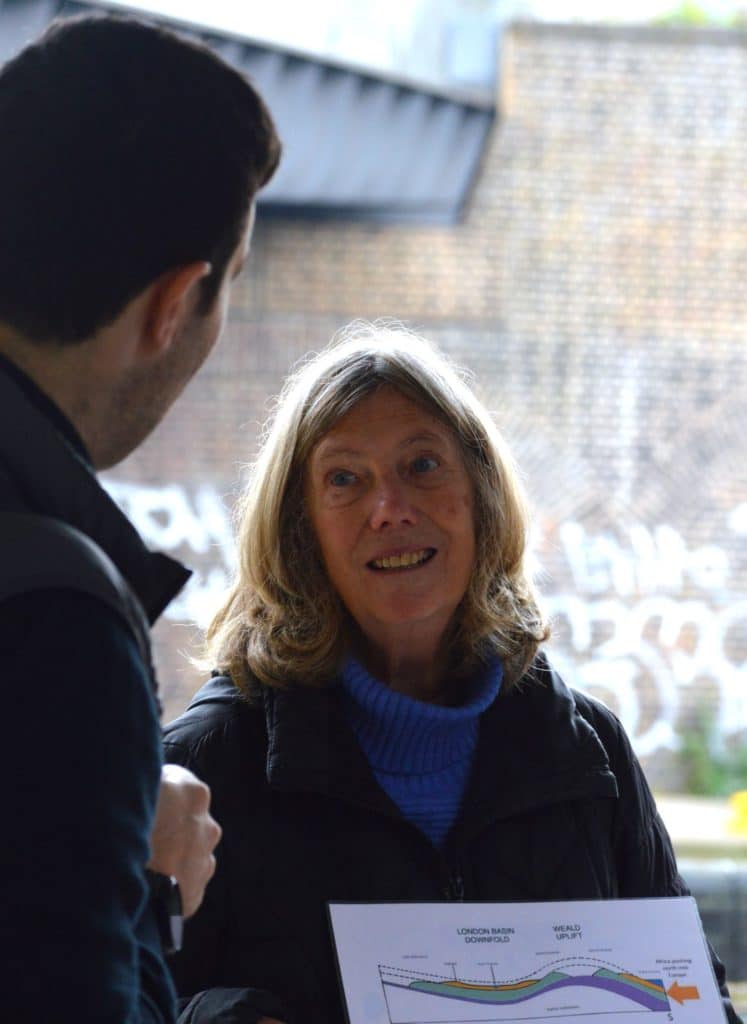
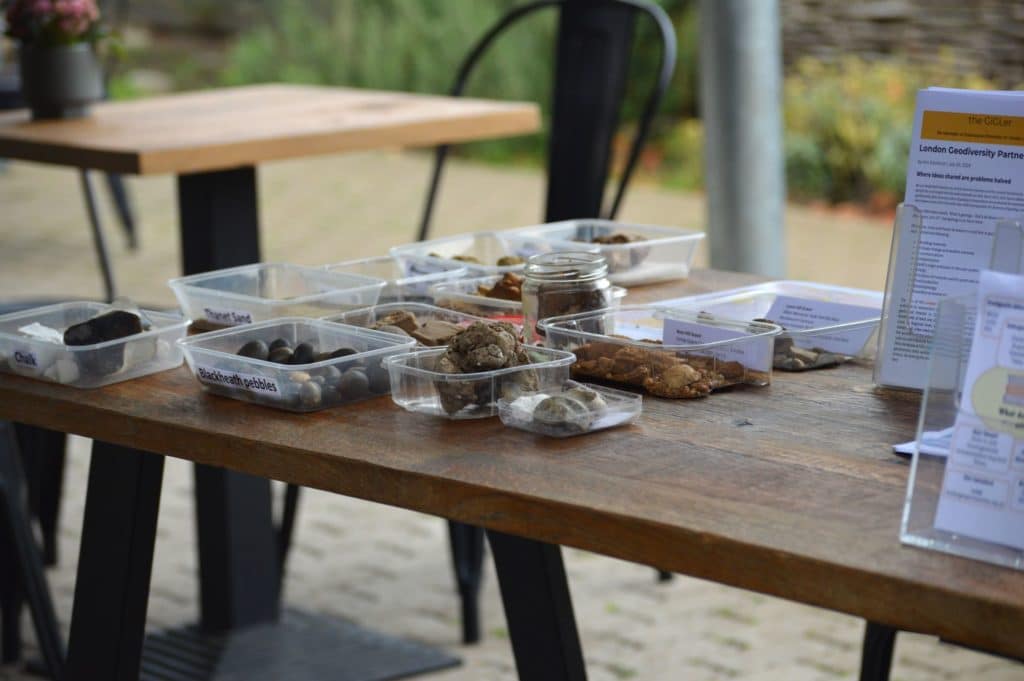
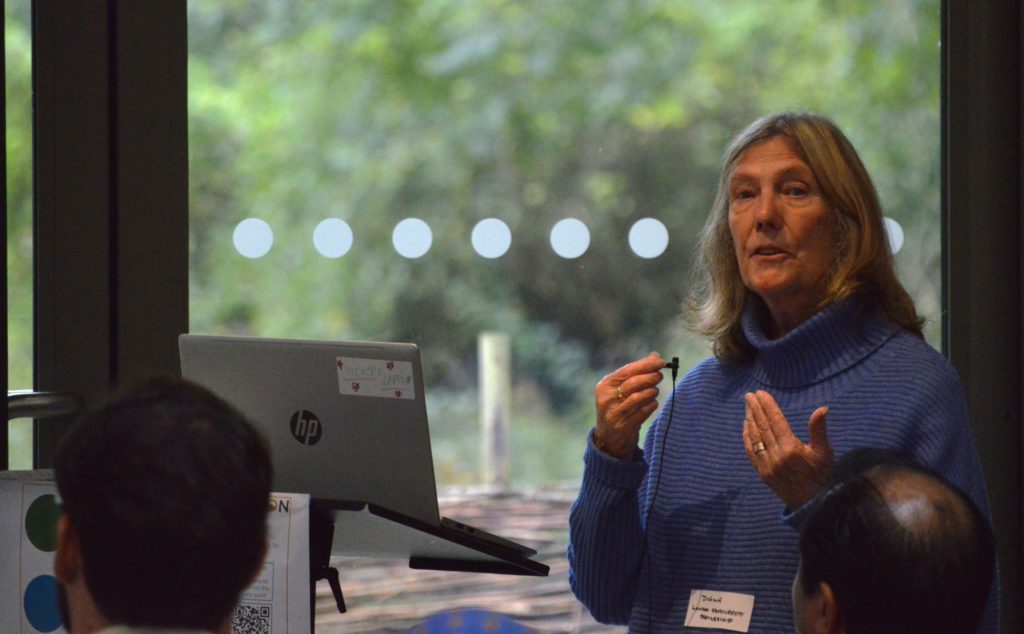
In our next speed talk, Susanna Thorton, recent Biodiversity Lead from Friends of St John’s Gardens burst with inspiration and useful lessons for the new recorder as well as more established projects. Susanna and the Friends’ recording journey began with the old adage ‘it’s better to do it badly than have nobody do it all!’. Seeing the passion of the group to experiment, learn and adapt to create a site for locals and local nature, it’s clear that ‘it’, is actually going very well indeed! The Friends began with some tips from the Friends of Finsbury Park to assist in beginning recording on-site. After starting with birds, the Friends moved on to pollinators, spiders and earlier this month, they even shared the records from their first fungal survey with GiGL. A true example of best practice in action!
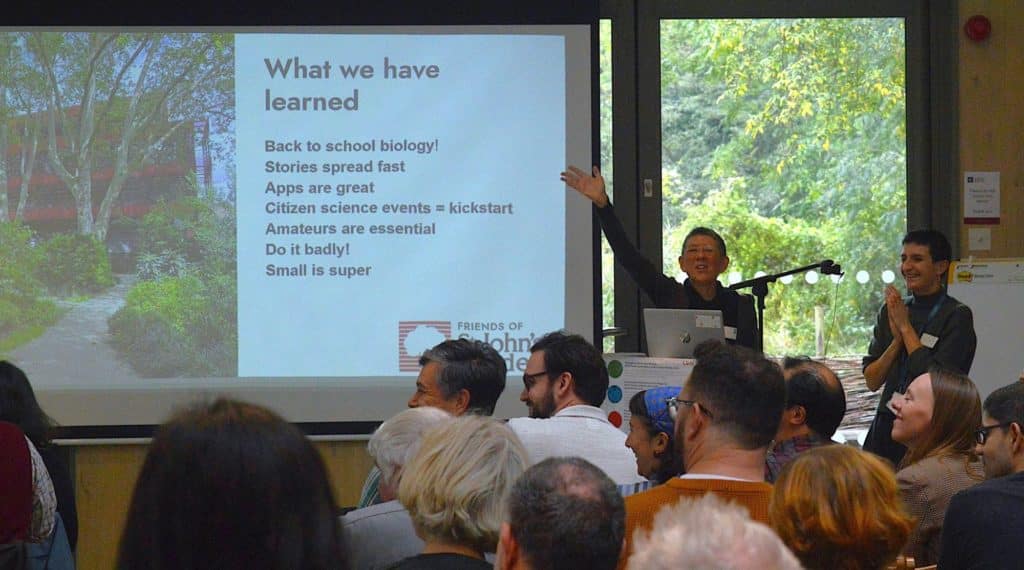
They have been undeterred by Farringdon’s notoriously grey landscape and have seized the chance to take meaningful ownership of the site. In taking responsibility for the management of the small site, the Friends are helping realise the cumulative potential of hodgepodge pocket parks and gardens as wildlife stepping stones and corridors across Islington. By ‘just going for it’, they have even inspired a neighbouring site ~500m away to also ‘take the leap’ and contribute. Susanna’s enthusiasm could be the spark needed to communally sustain Russell Miller’s ecological praxis in community projects – staying curious, acknowledging mistakes and learning collectively from, your patch. For your own little dose of optimism and motivation, follow the Friends on Instagram.
Our third and final speed-talk of the day was from Ellen Bidulka, Biodiversity Lead at Energy Garden. Energy garden is innovating the funding of community gardens, through revenue generated from the sale of solar energy in community energy projects. Ellen is pioneering combining biodiversity and habitat monitoring techniques for small, urban communal garden spaces. In the 2023 Energy Garden Biodiversity Report, Ellen meticulously detailed her and her volunteer’s use of the BNG small sites metric, vegetation surveys and diligent use of iNaturalist across all 17 Energy Garden sites, and has created a brilliant strategy that other small spaces can employ.
By partnering with TfL Overground on solar energy projects through corporate power purchase agreements, Energy Garden has identified easy gains for biodiversity, the community as well as securing long-term funding for both. Energy Garden is also helping community members to take ownership and control of green energy generation projects through the Community Benefit Society for invested members. Check out Energy Garden sites near you, stay tuned for the 2024 Biodiversity Report and learn more about community energy generation at the Energy Garden website.
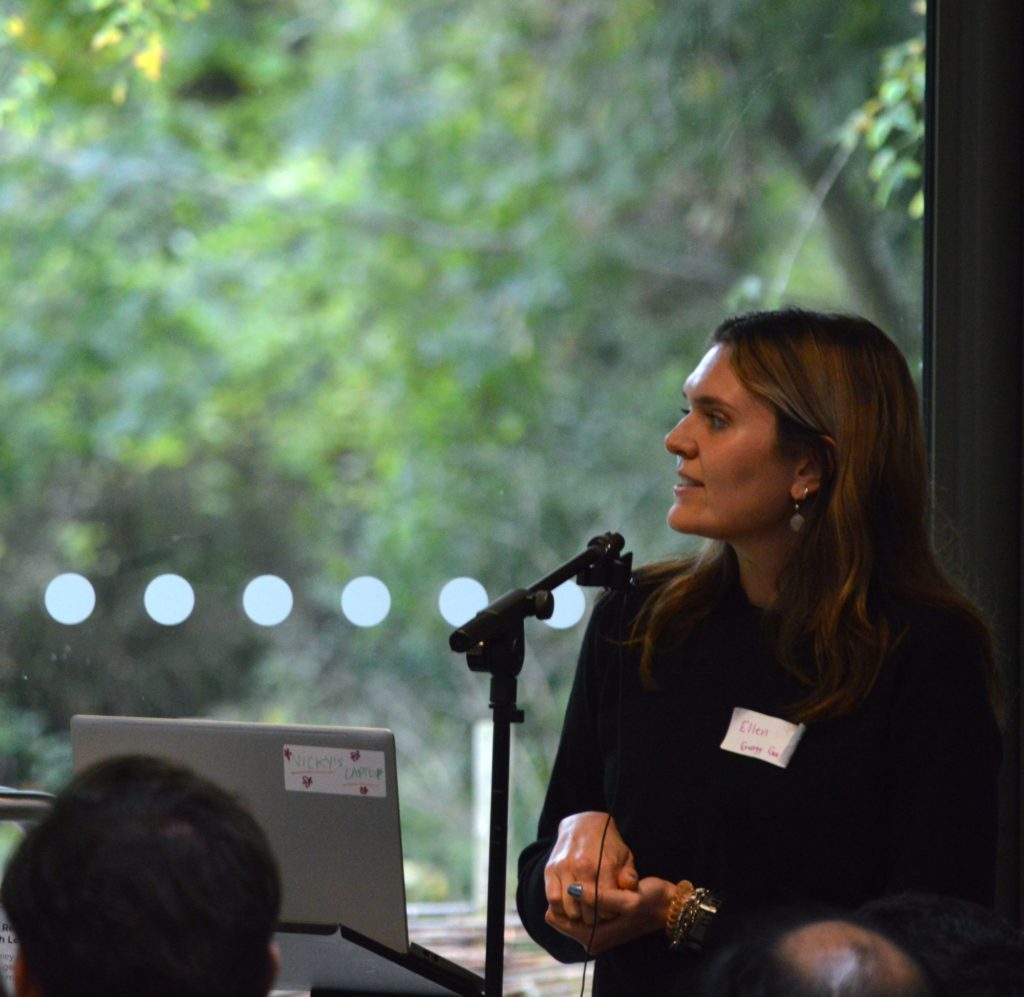
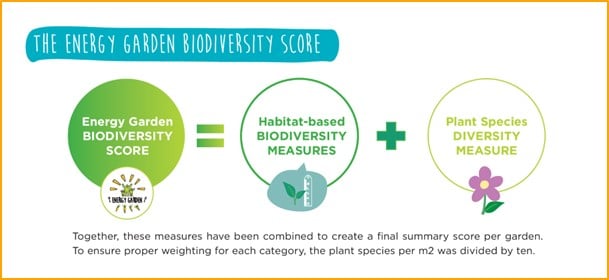
Our wonderful speed-talkers have definitely cemented this format into future LDN’s as a way to celebrate more diverse, local groups operating in London.
Keeping Tabs on Non-native Species
For a refreshing nationwide perspective, this year we welcomed Zoë Golding, Senior Inspector for the Great Britain Non-Native Species Secretariat (GBNNSS). Operating under the remit of the Animal and Plant Health Agency and made up of just 16 staff, the GBNNSS helps protect UK ecosystems from non-natives posing a risk to normal ecosystem functioning. Of over 2000 species that have been introduced to Great Britain, around 10-15% have come to be classed as invasives, translating into high economic management costs.
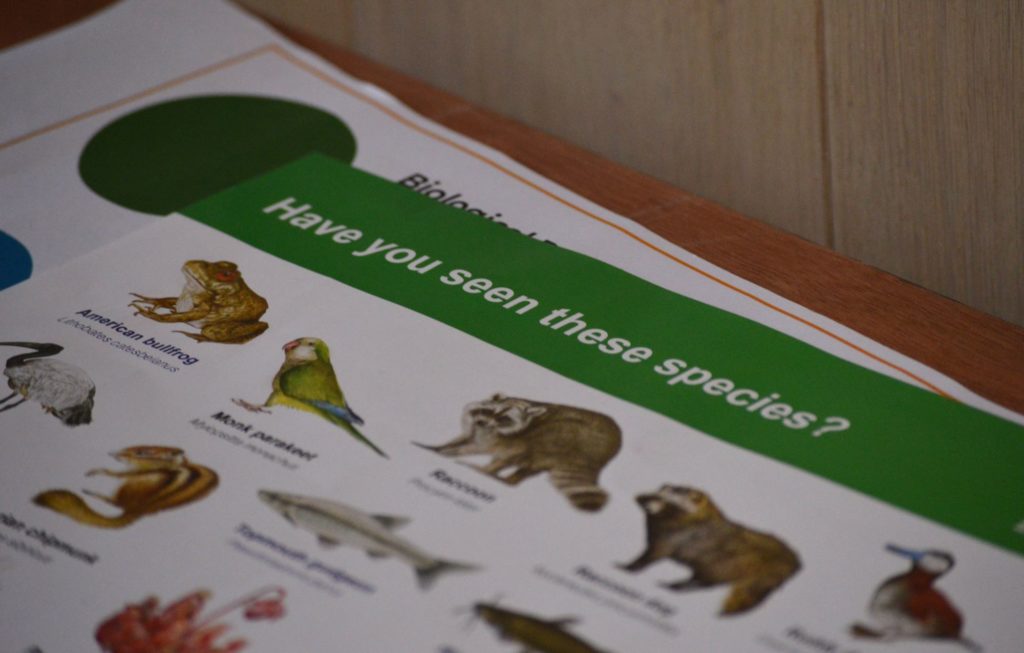
To combat this, Zoë’s job comprises some surprisingly thrilling tasks – intercepting cargo to check for contaminant and hitchhiker species sneaking across the channel. Or stealthily swapping the eggs of one of the 9 remaining Monk Parakeets in the UK with fakes to prevent further population expansion. Even rendezvousing to the secret zoo in Yorkshire, home to the outlawed species confiscated, captured, and liberated across the UK to live out their days comfortably but contained.
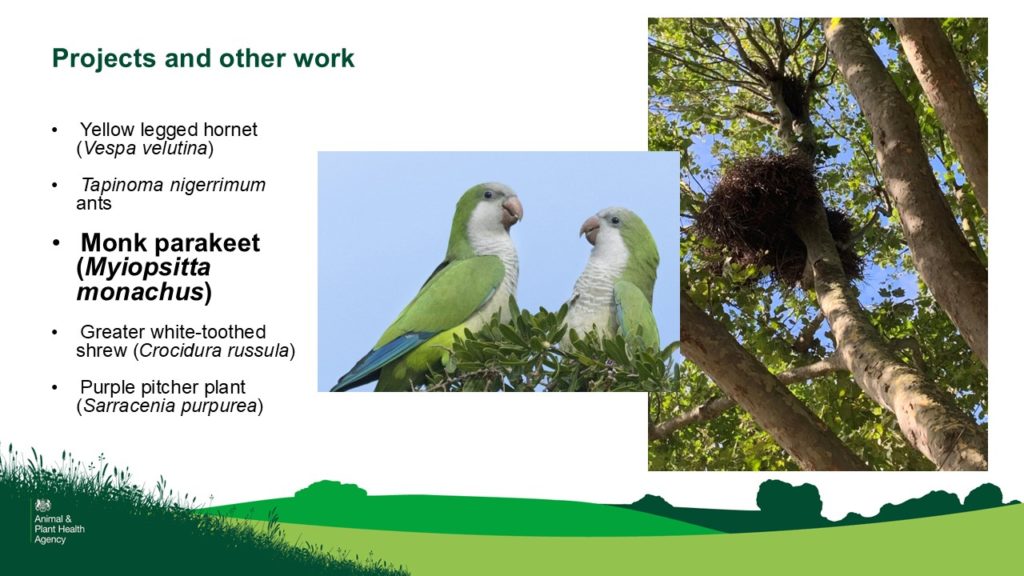
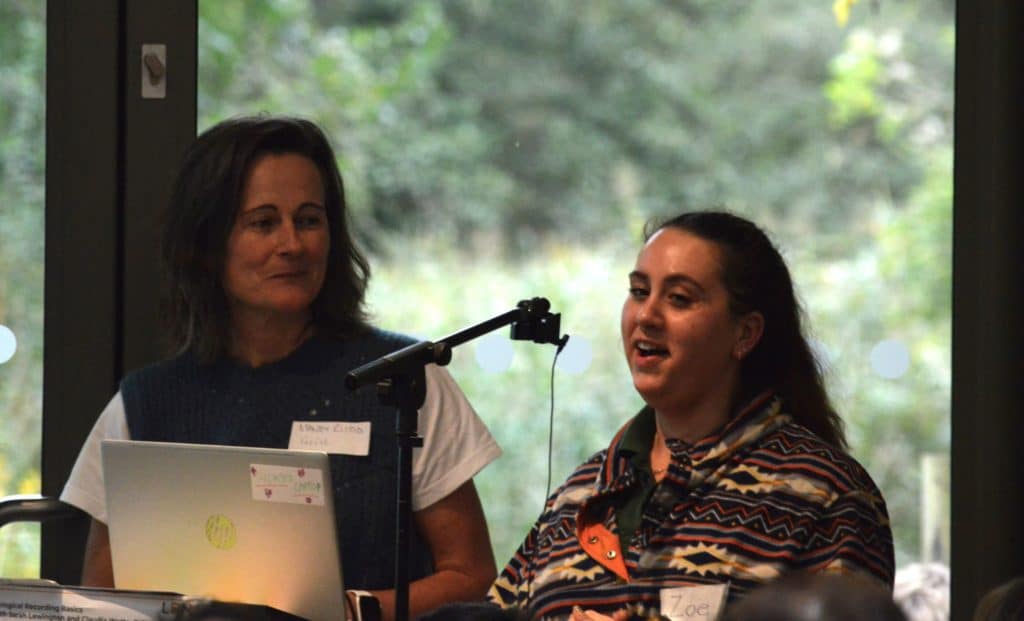
Zoë versus the monk parakeet – an invasive non-native species which has almost been eradicated from the UK. Not to be confused with London’s beloved ring-necked parakeet which is in most places. Right image: © Louisa Bizzarri, GiGL Partnership Officer.
In addition to the glamour of enforcing the Invasive Alien Species (Enforcement and Permitting) Order 2019, a large part of GBNNSS’s work is to educate. Zoë and colleagues educate members of the public, professionals, trade bodies and hobbyists to identify Invasive Non-Native Species (INNS), understand the threats they pose and the simple actions which help limit their spread. A particularly successful education campaign was ‘Be Plant Wise’ to help gardeners and retailers recognise if they are growing or selling INNS plants, keep them contained and disposed of correctly.
You can help monitor INNS species using the brilliant INNS Mapper app, specifically tailored to recording and surveying INNS. Using it, you can easily record both plants and animals, their distribution as well as log any management actions. The app has been used to great effect in coordinating joint efforts to remove Creeping Pennywort from the Calder and Colne catchments in North Yorkshire.
At home, the London Invasive Species Initiative is undergoing review to ensure that London-specific INNS threats are accurately assessed.
You can find links to the work of all speakers in our virtual Delegate Pack, where you can also find the feedback form (hint hint). Read next month’s instalment for an overview of the remainder of the day with contributions from the London Wildlife Trust, The Bumblebee Conservation Trust and much, much more!
Contact me at Victoria.kleanthous@gigl.org.uk
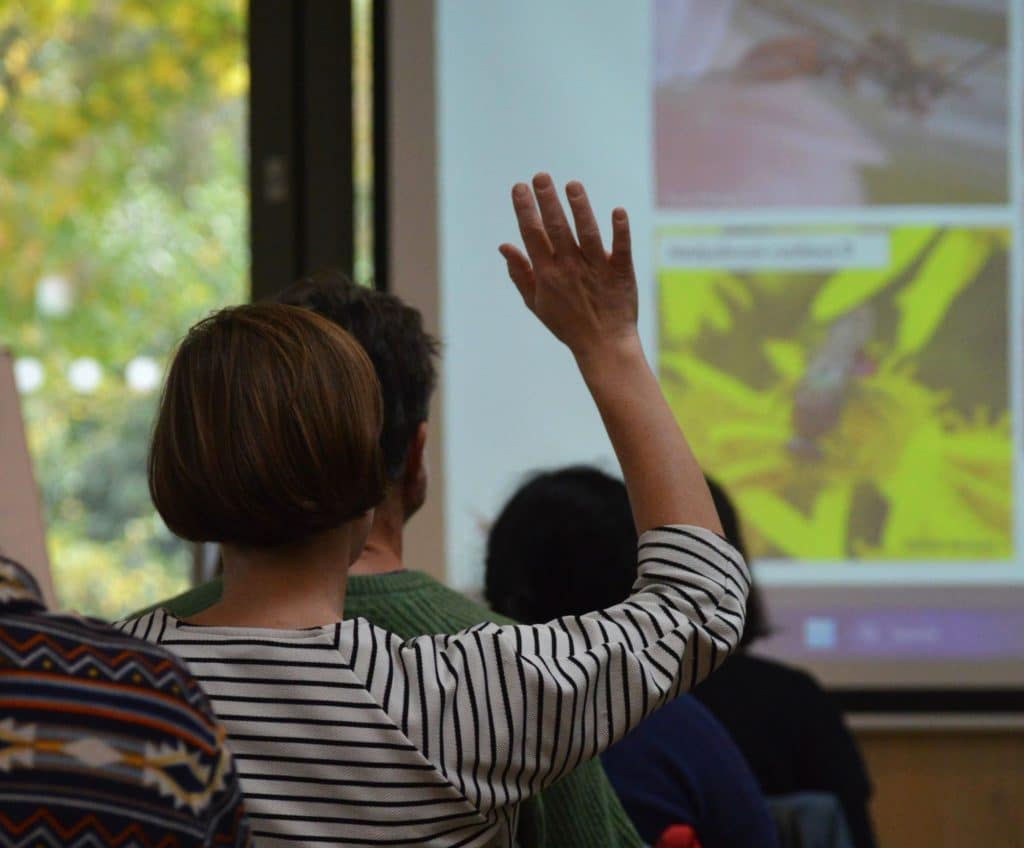
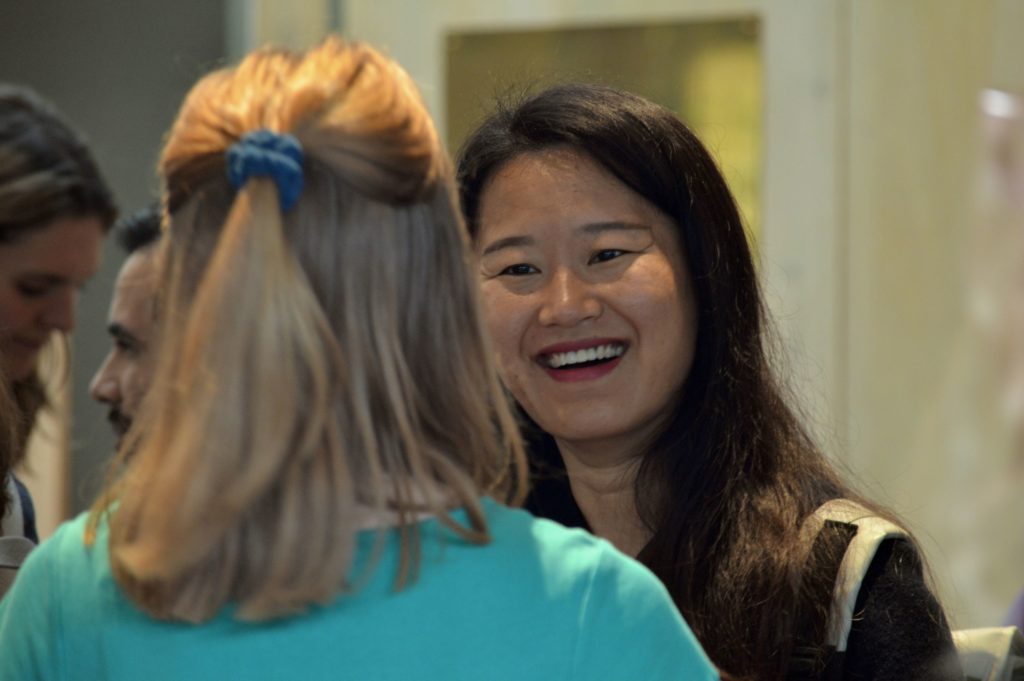
LDN24 attendees grilling the speakers and old friends re-connecting. © Louisa Bizzarri, GiGL Partnership Officer.
